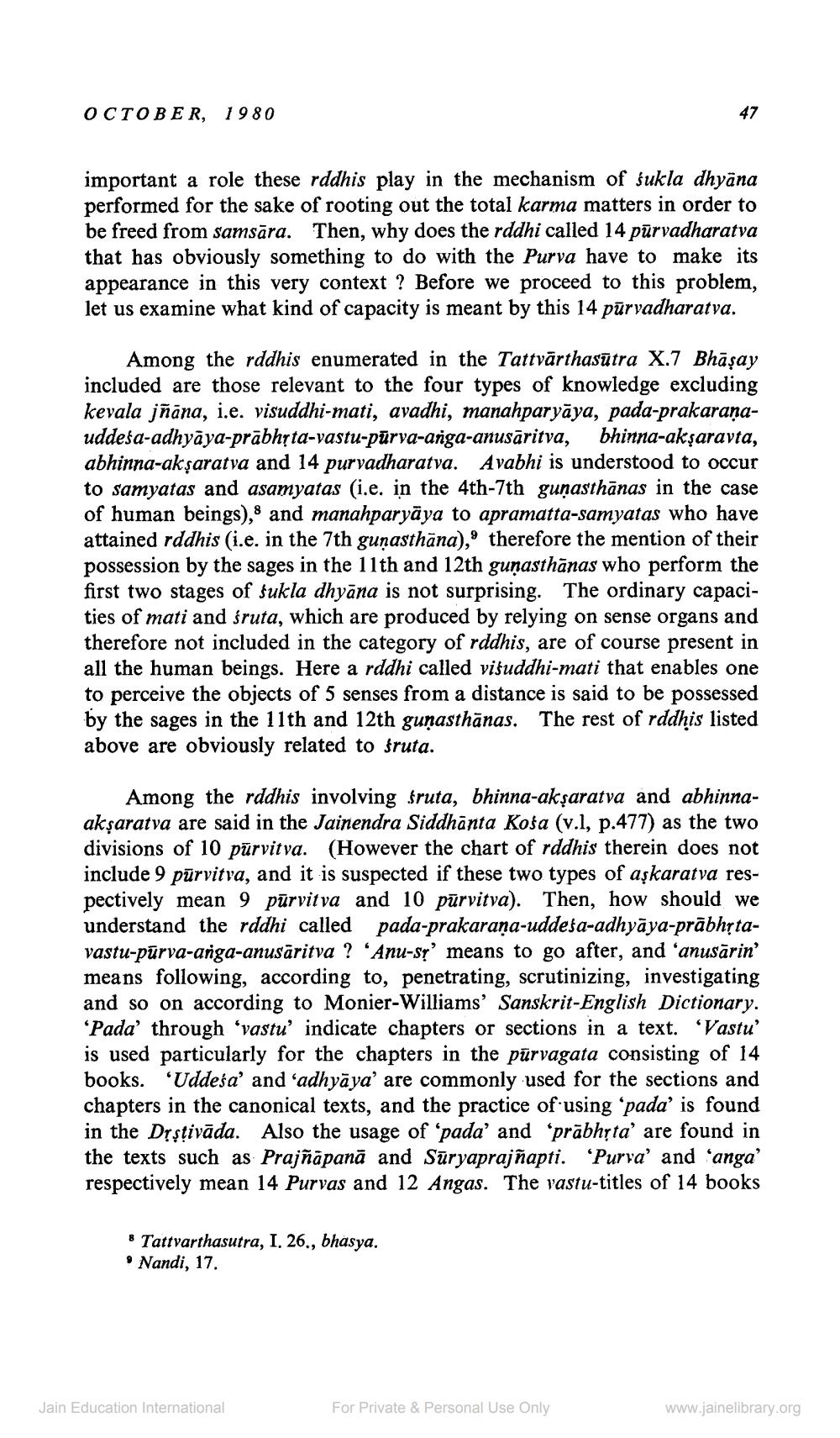Book Title: Jain Journal 1980 10 Author(s): Jain Bhawan Publication Publisher: Jain Bhawan Publication View full book textPage 9
________________ OCTOBER, 1980 important a role these rddhis play in the mechanism of śukla dhyāna performed for the sake of rooting out the total karma matters in order to be freed from samsāra. Then, why does the rddhi called 14 pūrvadharatva that has obviously something to do with the Purva have to make its appearance in this very context ? Before we proceed to this problem, let us examine what kind of capacity is meant by this 14 pūrvadharatva. Among the rddhis enumerated in the Tattvārthasūtra X.7 Bhāşay included are those relevant to the four types of knowledge excluding kevala jñāna, i.e. visuddhi-mati, avadhi, manahparyāya, pada-prakaranauddesa-adhyāya-prābhịta-vastu pūrva-anga-anusāritva, bhinna-akşaravta, abhinna-aksaratva and 14 puryadharatva. Avabhi is understood to occur to samyatas and asamyatas (i.e. in the 4th-7th gunasthānas in the case of human beings), and manahparyāya to apramatta-samyatas who have attained rddhis (i.e. in the 7th gunasthāna),' therefore the mention of their possession by the sages in the 11th and 12th gunasthānas who perform the first two stages of sukla dhyāna is not surprising. The ordinary capacities of mati and fruta, which are produced by relying on sense organs and therefore not included in the category of rddhis, are of course present in all the human beings. Here a rddhi called visuddhi-mati that enables one to perceive the objects of 5 senses from a distance is said to be possessed by the sages in the 11th and 12th gunasthānas. The rest of rddhis listed above are obviously related to fruta. Among the rddhis involving sruta, bhinna-aksaratva and abhinnaakşaratva are said in the Jainendra Siddhanta Kosa (v.1, p.477) as the two divisions of 10 pūrvitva. (However the chart of rddhis therein does not include 9 pūrvitva, and it is suspected if these two types of aşkaratva respectively mean 9 pūrvitva and 10 pūrvitva). Then, how should we understand the rddhi called pada-prakarana-uddesa-adhyāya-prābhrtavastu-pūrva-arga-anusäritva ? Anu-Sr' means to go after, and 'anusārin' means following, according to, penetrating, scrutinizing, investigating and so on according to Monier-Williams' Sanskrit-English Dictionary. 'Pada' through 'vastu' indicate chapters or sections in a text. Vastu' is used particularly for the chapters in the pūrvagata consisting of 14 books. 'Uddeśa' and 'adhyāya' are commonly used for the sections and chapters in the canonical texts, and the practice of using 'pada' is found in the Dşstivāda. Also the usage of 'pada' and 'prābhịta' are found in the texts such as Prajñāpanā and Sūryaprajñapti. "Purva' and 'anga' respectively mean 14 Purvas and 12 Angas. The vastu-titles of 14 books 8 Tattvarthasutra, I. 26., bhasya. . Nandi, 17. Jain Education International For Private & Personal Use Only www.jainelibrary.orgPage Navigation
1 ... 7 8 9 10 11 12 13 14 15 16 17 18 19 20 21 22 23 24 25 26 27 28 29 30 31 32 33 34 35 36 37 38 39 40 41 42
